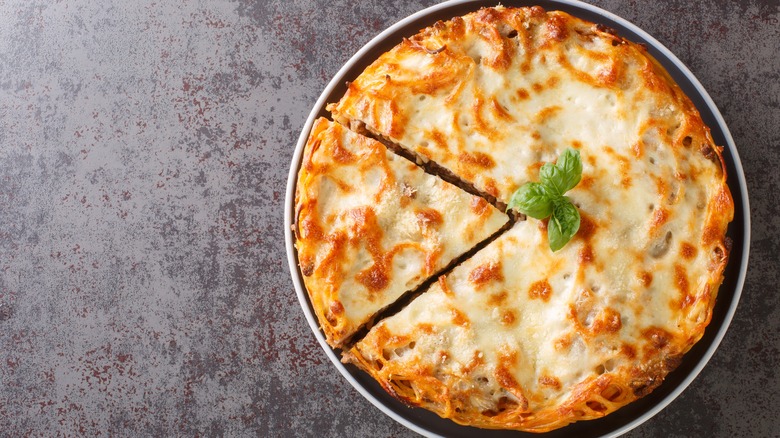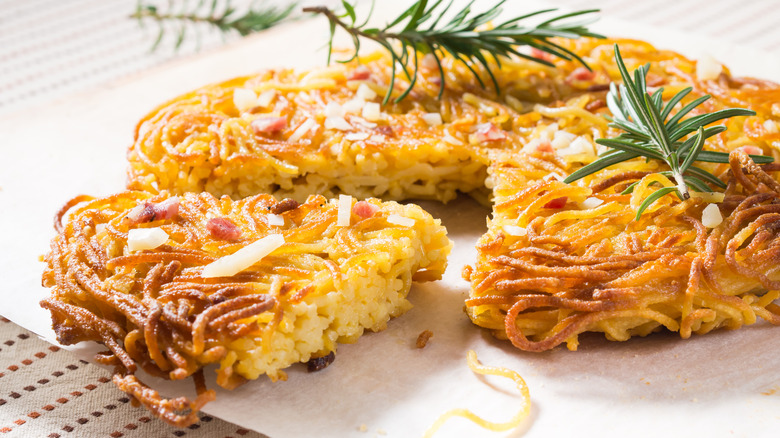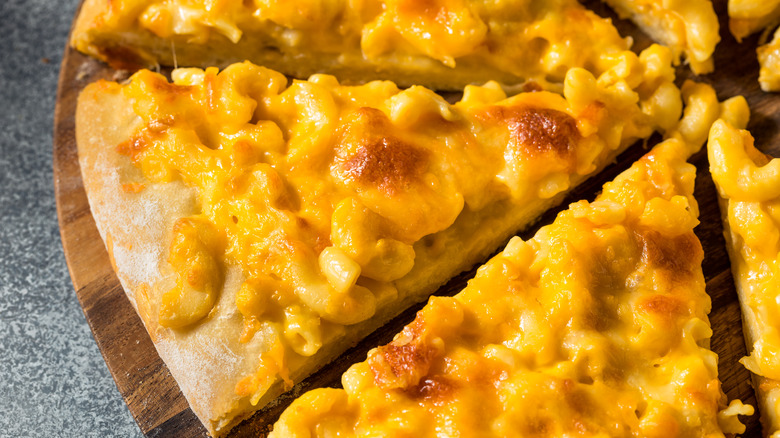Pasta Is The One Ingredient Your Pizza Has Been Missing
Sometimes even our comfort foods need a refresh. Although we'll always cherish a classic slice of pizza, there's another roasted disc that has captured our attention. Instead of the usual dough and sauce, we're using pasta to make pies stand out. It's a delicious addition to the top of any creation, but cooks can also repurpose leftover noodles to form the actual base of their pizza.
As lasagna enthusiasts are aware, noodles can exhibit a multitude of textures. In this instance, when used as the base of the pie, the exterior noodles bake up crispy, crunchy, and caramelized, while the center remains soft and velvety. This is all the more reason to experiment with incorporating this carb into your cheesy, saucy dinner routine.
To use pasta in place of the usual pizza crust, cooks should mix cooked spaghetti or another long strand, such as linguine or fettuccine, with two to four eggs to loosely bind the starch together. If you're a fan of red sauce, incorporate marinara or vodka sauce into the mixture, along with seasonings like parmesan, garlic powder, dried basil, red pepper flakes, and mozzarella. Then, crisp the mixture either on the stove in a frying pan, or on a sheet pan in the oven. Top it like a regular pizza with more sauce, shredded cheese, and pre-cooked toppings, then allow it to finish browning in the oven.
Baking pasta crust pizza at home
The trick to achieving maximum crispiness on the top and bottom of the pie is to first let the mixture brown slowly in a warmed skillet for a few minutes. While cooks can opt to pop the noodles in a baking dish and cook them, they risk ending up with a dish that's more akin to a casserole than a pizza pie.
Once you've mastered the technique, experimental chefs can play with the thickness of the "crust." A thinner layer will yield a crunchier base, whereas a generous serving of spaghetti will resemble a deep dish style. Similar to making deep dish pizza at home, place the prepared noodles in a greased springform pan instead of a skillet to cook through.
This flexibility in crust creation is just one of the many advantages of making pasta-based pizza. Besides the delightful tastes and textures, another benefit for busy households is the ability to use store-bought shortcuts and leftover meals in the dish. Beyond incorporating yesterday's dinner into the crust, you can also utilize any marinara sauce nearing its expiration in the fridge. Defrosted frozen vegetables or meatballs can spice up the toppings or filling as well.
Pasta-topped pizza ideas
If one carbohydrate just isn't enough, or you simply can't say goodbye to a dough crust, you can also use pasta as a textured topping. Bake a pizza crust with sauce, cheese, and a thin layer of sauced pasta. Or, if you're feeling decadent, add ravioli that has been crisped or fried on the stove.
Regardless of where the starch fits into your pie, it's important to use cooked noodles in this dish. Busy cooks can even transform their pepperoni pizza pasta bake back into its original form by layering the noodles onto a dough crust. Sauce is key to preventing the pasta from becoming too dry and brittle, so be sure to generously dress up buttered noodles before giving them a second life.
Fans of white pizza and cheese lovers can take a creamier approach by microwaving frozen macaroni and cheese (or preparing the boxed variety) to layer on a pie. Chicken Alfredo, which can become gluey when reheated, can also be revitalized with a quick blast under the broiler. Or, enhance the flavor with a smear of garlic butter before adding creamy, meaty carbonara and plenty of cheese.



